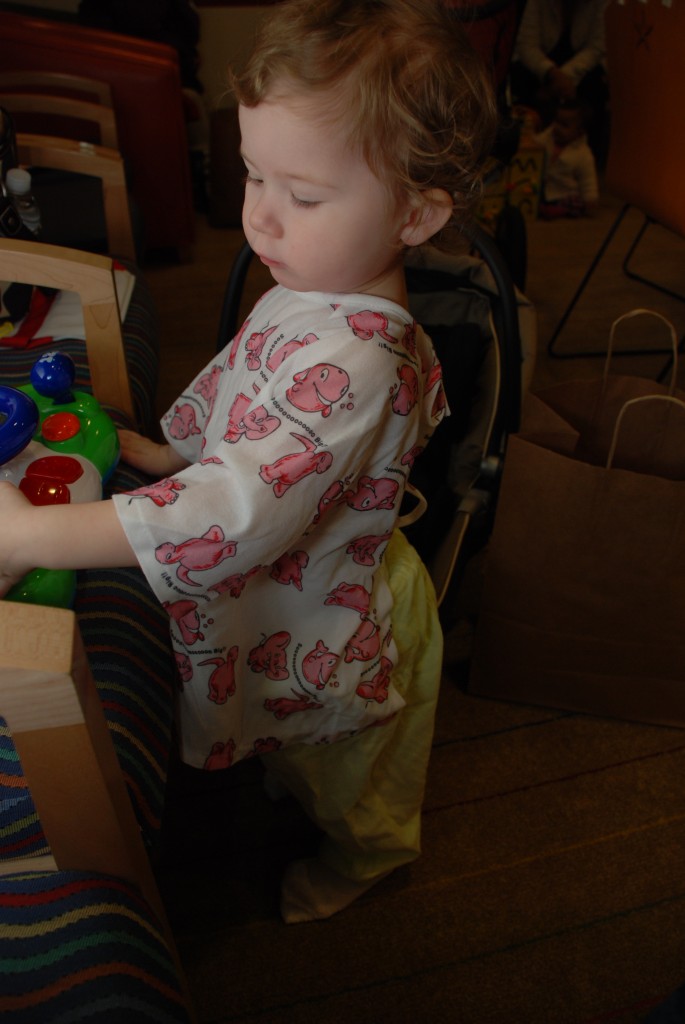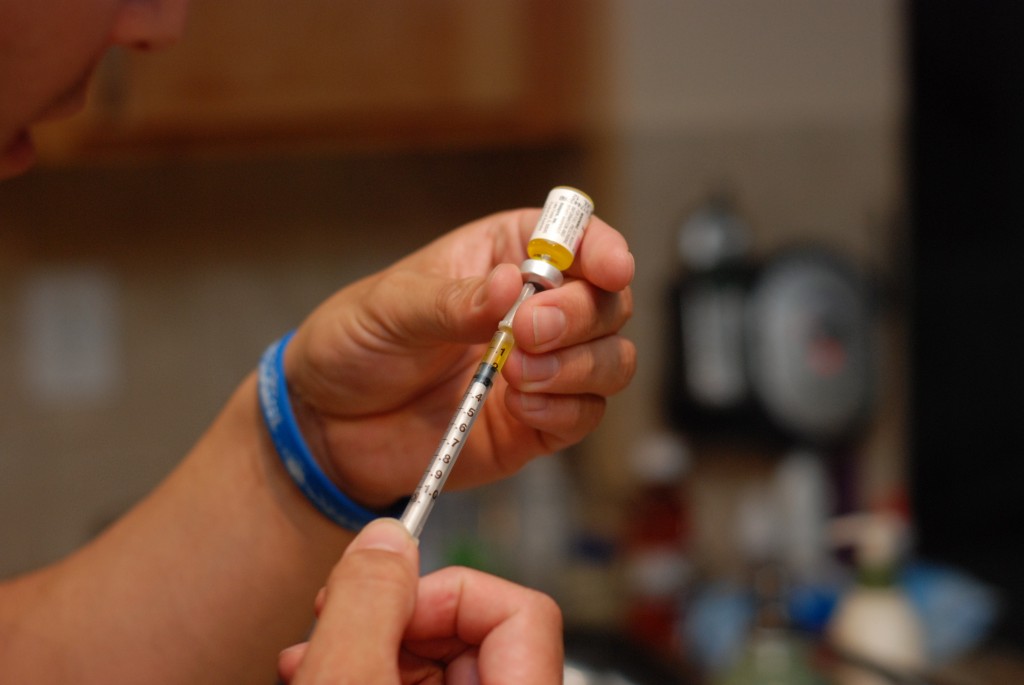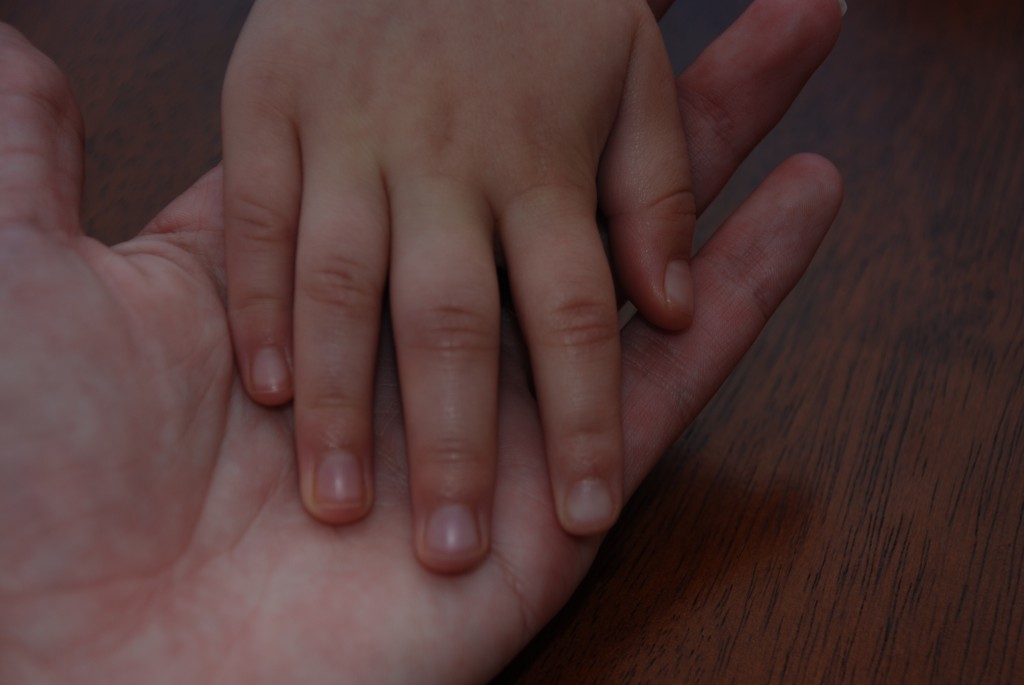At the end of Part One we we had just gotten to our appointment at Stanford’s Pediatric Rheumatology Department….
And HEY! I was nearly 39 weeks pregnant with Everett at this point? Again- fun times!
ANYWAY.
At this appointment, E was seen by both an attending physician and a clinical fellow. The fellow did a thorough examination followed by the attending. When the attending did her exam, she also noted swelling on E’s right middle finger- between her joints. Sure enough- her tiny finger had swelling we hadn’t yet noticed.
At this point, they delivered the news that they were diagnosing her with the condition I already suspected: Oligo Juvenile Idiopathic Arthritis- meaning less than 5 joints were involved. This was about 5 weeks after we first noticed the slight limp. Typically symptoms have to be present for 6 weeks for a JIA diagnosis but they said the likelihood of her symptoms disappearing in the next week were slim- and they were correct.
They explained to us what I had already read about online: JIA, or JA as I tend to refer to it as, is an auto-immune disease where the immune system goes crazy and attacks healthy tissue- in this case the tissue in her joints. There is no current known cause (hence the term idiopathic) nor any cure for JA. Just treatments. JA used to be called JRA- Juvenile Rheumatoid Arthritis- but this is an outdated term. They changed it because the rheumatoid factor isn’t present in most kids with Juvenile Arthritis (unlike adult Rheumatoid Arthritis).
According to the Arthritis Foundation: “Arthritis effects the musculoskeletal system and specifically the joints – where two or more bones meet. Arthritis-related joint problems include pain, stiffness, inflammation and damage to joint cartilage (the tough, smooth tissue that covers the ends of the bones, enabling them to glide against one another) and surrounding structures. Such damage can lead to joint weakness, instability and visible deformities that, depending on the location of joint involvement, can interfere with the most basic daily tasks such as walking, climbing stairs, using a computer keyboard, cutting your food or brushing your teeth.” (www.arthritis.org)
This may not sound severe, but let me tell you that this disease can do serious damage to the body, and in severe cases, can actually be deadly. Esella has permanent damage in her right knee from inflammation on and off for years. Have you ever seen the fingers of an older person that are gnarled from years of arthritis? Though the causes are different, this can happen to children who suffer from this disease if it is not properly treated.
And yes though rare, children die from complications of juvenile arthritis. A sweet young girl who ironically was named Ellie, a nickname we call E, just recently passed away from complications of this disease.
She died. From complications of Arthritis.
This isn’t your grandmother’s arthritis: this is a serious auto-immune disease.
The thing is- JA doesn’t limit itself to joints. If it isn’t enough that the immune system attacks its own joints, many children with JA are at a high risk for a condition called Uveitis, which is inflammation in the eyes that often has no symptoms until damage has been done- and can even cause permanent blindness. In some children with JA, particularly with systemic JA, the organs are affected as well- including the heart.
Like I said: serious disease.
We were told that occasionally children “outgrow” JA (meaning they go into remission without it returning), particularly the subtype she was diagnosed with, but the reality is that it’s not that common. For most this is a life-long disease that needs life long management.
So management- or treatment.
Believe it or not, the treatment for this disease involves some pretty hard core medications. Some are the same ones used for chemotherapy (but in lower doses). Some children do not respond to these medications alone (which, by the way, are typically given via injection weekly at home) and these children often have to move on to even more aggressive medications that are typically given via infusion every few weeks or so. The goal of these medications is to suppress the immune system just enough that it stops attacking itself.
Another common treatment is steroid injections directly into the affected joint(s). This was the first type of treatment E had at age two (and again at age 7). Because of her age, it was necessary to have her put under general anesthesia. Going under is scary for anyone…but let me tell you it is really scary having to put your toddler under. We also found out that toddlers tend to have the worst reactions when coming out of anesthesia. E was no exception. The poor girl screamed for three hours straight after her procedure. It was heartbreaking.

There’s E while we waited for her injection procedure.
Did I mention that when she had her injection we had an 8 day old? That we had to bring with us to the hospital because I was breastfeeding and I wasn’t going to NOT be there when my baby had her procedure done? It was a tricky day but we made it work and it went really well. (We were supposed to have help with us that day- but my mother in law ended up with a cold so she couldn’t come help either).
All of this took place NINE years ago- which is crazy to me! It feels like both yesterday and like an eternity ago. It’s a weird feeling.
E has been receiving injections at home weekly on and off for almost 9 years now. We’ve always given her breaks to be off her meds when she goes into a medicated remission- but unfortunately every time she has a break, the symptoms return at some point and usually worse than before (meaning in new joints). Technically these medications place her into the “immune compromised” category because they are meant to suppress her immune system just enough to keep it from attacking her body. Thankfully her immune system is SO GOOD that she rarely gets sick even on her meds. However being immune compromised means she’s at a higher risk of complications from everyday illnesses, which is scary.

(Picture above is Justin pulling up E’s Methotrexate injection when she was two- this is a chemotherapy medication that she was on for about a year).
Over these last 9 years, E has been on and off of injectable medications and recently just started her 3rd type. When she was younger, her fingers were quite involved and would swell on and off, like the picture below.

As she’s gotten older, it has mainly stayed in her bigger joints- like her knees. Also when she was younger it only affected the right side of her body, where as now she has some involvement on the left side of her body- in her knee.
Over the years, her arthritis has caused swelling, pain, and limited movement in the affected joints. In first grade, she had a flare that caused me to have to piggy back her in to school each morning for a couple weeks until she was able to have a cortisone injection (I was newly pregnant with E4). This particular flare was probably her worst yet as the pain was pretty unbearable in the mornings until her joints could warm up. In fact, we went snowboarding during that time and though she powered though the pain, the aftermath was rough. She had other flares between now and then but those were milder.
So that brings us to the present. If you’re on Facebook you might have seen my posts about E having an MRI last week. She’s had some pain in her neck and jaw for several months now- and she is currently in another flare- so we decided that it was important to see if the cause was arthritis or possibly from another connective tissue disease she has. We did receive the results online but haven’t spoken to the doctor yet to discuss them- I’ll just say for now that I’m glad we did the MRI!
I wish I could say that is the end of E’s story, but it’s not. There’s more to share- soon.
Leave a Reply